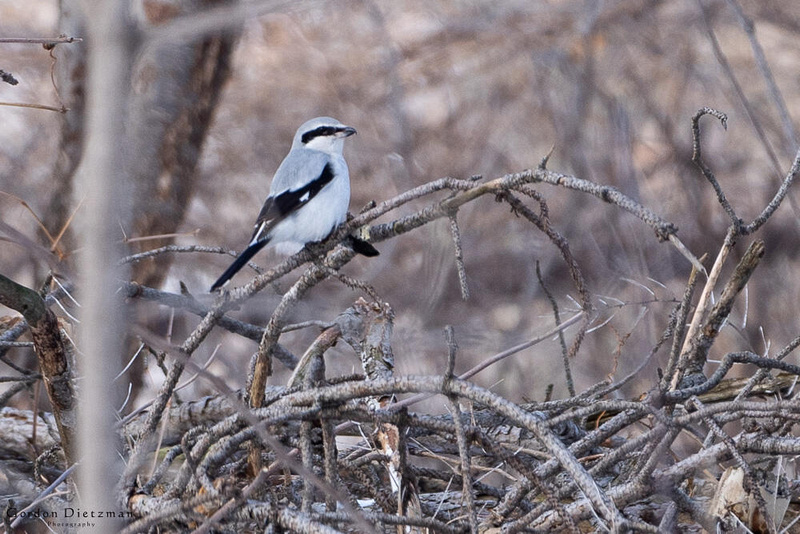On my usual Villa Park hike yesterday, I encountered another hiker that mentioned seeing what he thought was a shrike. I hurried to the location excitedly as I rarely see these birds. In fact, I've only recorded one in the last 20 years of living on the edge of Villa Park. They are elegant birds dressed in formal gray and black and they breed in the far north of the continent migrating south for the winter to the relative balminess of Minnesota winters.
 Northern Shrike
Northern Shrike They are one of the more interesting songbirds because of a lifestyle that is fairly unique among songbirds. They have a fun, bubbly, warble of a song, but this bird plays up that role of innocent songster in a rather surprising way. Most songbirds eat a lot of insects and seeds and the robin-sized shrike will as well but that hooked bill is a bit ominous. It hints at a different lifestyle and shrikes live up to that hint by taking not only insects, but mice, voles, and even other birds, including those that are larger than themselves!
They are one of the more interesting songbirds because of a lifestyle that is fairly unique among songbirds. They have a fun, bubbly, warble of a song, but this bird plays up that role of innocent songster in a rather surprising way. Most songbirds eat a lot of insects and seeds and the robin-sized shrike will as well but that hooked bill is a bit ominous. It hints at a different lifestyle and shrikes live up to that hint by taking not only insects, but mice, voles, and even other birds, including those that are larger than themselves!
Shrikes have strong feet but not as strong as a hawk's talons which the latter uses to kill its prey. Lacking that tool the shrike uses its bill to kill. That places its vulnerable eyes close to dangerous prey so they need to make a quick kill to reduce the possibility of injury to themselves. A shrike's bill have two small projections on either side of the upper bill that fit into corresponding notches in the lower bill. This "tomial tooth" provides a vertebrae-crunching bill that quickly incapacitates prey. Northern shrikes often catch more prey than they can eat at one time and the excess is cached often by impaling the victim on barbwire or thorns for consumption later on. This behavior gives them one of their alternative names of "butcher bird."
I found the shrike during yesterday's hike as it was consuming a freshly caught downy woodpecker. It flew off before I got any good photos of it, but this morning I searched the area again and found it polishing off the remains of yesterday's meal and got this photo. Northern shrikes are handsome, aggressive birds that masquerade as just another songbird, but with an appetite of a hawk, the ability to subdue large prey quickly, and to store it for future use. It's a fascinating, elegant-looking, uncommon bird which we rarely get to see.
Being a naturalist tips the balance, I believe, in finding and photographing birds and other animals. For instance, I knew that shrikes set up winter territories so I was likely to find the elusive bird again if I hung around the area where I first spotted it. Secondly, a downy woodpecker is about half the size of a shrike, which makes it a very significant meal. I suspected that the shrike had not finished the meal but had probably cached the remains in or around the brush pile where I first spotted it. While I didn't see the cached remains, I was back at the brush pile the next day where I found the shrike finishing his meal.
Understanding behavior of a target species allows the nature photographer to increase the likelihood of finding subjects.